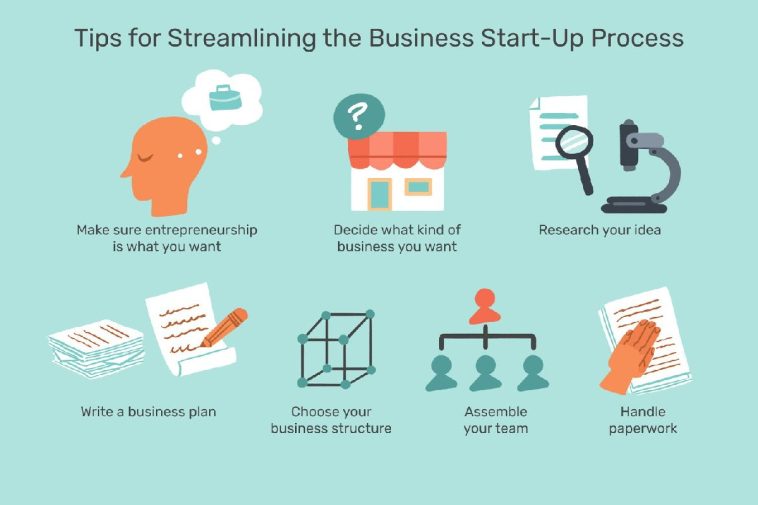Steps to Help You Establish Your Business – Business refers to the organized effort of individuals or groups to produce and sell goods or services to generate profits. It involves various activities such as manufacturing, trading, finance, marketing, and operations. Businesses can be small-scale operations run by a single individual or large corporations with thousands of employees. Thus, establishing a business requires careful planning and execution.
Here are Some Steps to Help You Establish Your Business
1. Identify Your Business Idea:

Determine the type of business you want to start based on your skills, passion, and market demand. Conduct market research to assess the viability of your idea. Determining the type of business requires understanding its core operations and industry focus. Factors like products or services offered, target market, and revenue model play a role. Whether it’s a retail store, a software development firm, consulting agency, or a restaurant, you can define the type of business by its unique characteristics and nature of operations.
2. Create a Business Plan:
Outline your business goals, target market, products or services, marketing strategy, financial projections, and operational details in a comprehensive business plan. It will serve as a roadmap for your business. A cutting-edge technology startup that develops AI-powered virtual assistants for businesses. Our scalable platform provides intelligent customer support, automates repetitive tasks, and enhances decision-making processes. With a focus on user experience and customization, we aim to revolutionize how companies interact with their customers and optimize operational efficiency.
3. Secure Financing:
Determine the financial requirements of your business and explore various funding options such as personal savings, loans, investors, or grants. Develop a financial plan to manage your startup costs, operating expenses, and cash flow. To secure financing, gather all relevant financial documents, create an effective business plan, approach lenders or investors with a clear and concise pitch, demonstrate your ability to repay the loan or generate returns, and provide collateral or guarantees to mitigate risks. Build relationships, be persistent, and also explore various funding options.
4. Choose a Legal Structure:
Select the appropriate legal structure for your business, such as a sole proprietorship, partnership, limited liability company (LLC), or corporation. Consider liability protection, taxation, and ownership structure when making this decision. A flexible and popular legal structure unites a corporation’s advantages (limited liability protection) with a partnership’s simplicity and tax benefits. LLCs offer personal asset protection, pass-through taxation, and fewer administrative requirements than corporations.
5. Register Your Business:
Registering a business involves selecting a business name, determining the legal structure, obtaining necessary licenses and permits, and filing the required paperwork with the appropriate government agencies. Please choose a unique name and register it with the proper government authorities. Obtain any necessary licenses or permits required to operate legally in your industry.
6. Set Up Your Infrastructure:
Establish a physical or virtual location for your business, depending on your industry. Purchase or lease equipment, set up necessary technology systems, and create a professional online presence through websites and also social media profiles.
7. Develop a Marketing Strategy:
Identify your target audience and develop a marketing plan to reach and attract customers. Utilize online and offline marketing tactics, such as social media marketing, search engine optimization (SEO), advertising, and networking.
8. Hire the Right Team:
Determine the human resources needed to run your business effectively. Recruit and hire skilled employees who align with your business values and can contribute to its growth. Alternatively, consider outsourcing specific tasks or working with freelancers or contractors.
9. Branding and Marketing:
Develop a brand identity, including a logo, website, and marketing materials. Create a marketing strategy to promote your business and attract customers. Utilize online and offline marketing channels, such as social media, advertising, networking, and also public relations.
10. Establish Operational Processes:
Define the day-to-day operations of your business, including inventory management, production processes, customer service protocols, and quality control measures. Implement efficient systems and tools to streamline operations and also maximize productivity.
11. Monitor and Adapt:
Regularly review your business performance against your goals and make necessary adjustments. Stay informed about industry trends, customer preferences, and changes in the market landscape. Continuously innovate and also adapt your business strategies to stay competitive.
Conclusion
Remember, starting a business requires hard work, dedication, and perseverance. Hence seek advice from mentors or professionals in your industry and stay focused on your long-term vision.




GIPHY App Key not set. Please check settings